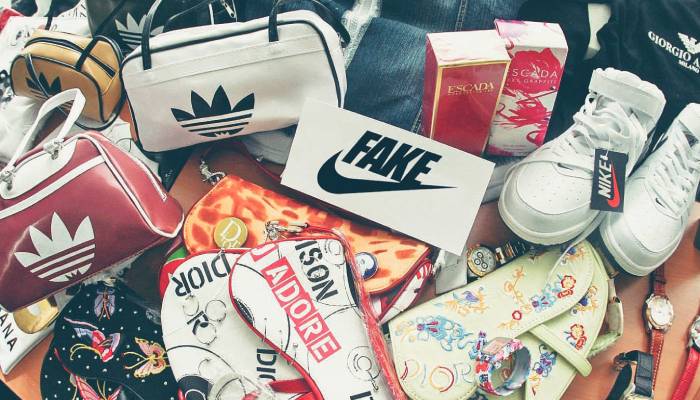
or

As per the Global Brand Counterfeiting Report, 2018 the amount of total counterfeiting globally has reached to 1.2 trillion USD and is certain to reach 1.82 trillion USD by the year 2020 which includes counterfeiting of all equipment and products ranging from submarines to clothes. The probable losses due to counterfeiting both offline and online, to fashion industry hover around 98 Billion USD.
The World Intellectual Property Organization (WIPO), which is responsible for the promotion of the protection of intellectual property throughout the world, considers counterfeit as a global threat which has been cutting revenues of both Industries and that of the Government while costing the global economy more than US$100bn a year. the World Customs Organization (WCO), whose mission is to improve the administration of customs, pirated and counterfeit goods account for
Roughly seven to nine percent of global trade and believes counterfeit inevitably becoming an active channel to lead to a diversion of funds to other illegal activities while treating consumers’ health and safety especially in the cosmetics and pharmaceuticals space.
Organization for Economic Co-operation and Development (OECD), the European Union’s Intellectual Property Office, and according to the Counterfeiting Intelligence Bureau (CIB) of the International Chamber of Commerce (ICC), counterfeit goods make up 5 to 7% of world trade and that originates from Singapore, Thailand, India with China topping the list with 63% followed by turkey in the estimated half-a-trillion dollar worldwide imports of counterfeit and pirated goods with India being the fifth biggest exporter of fake goods globally
Authentication Solutions Providers Association (ASPA) believes that the market for fakes in India has grown increasingly and steadily in the organized sector with a colossal share of Rs 40,000 crore, with high penetration into the FMCG sector and as per FICCI-KPMG report the counterfeit FMCG market in 2014 stood at Rs 68,000 crore with a growth trajectory of 10 percent of minimum of 10 percent over last two years causing a recurring and mounting loss of a minimum of Rs 27,500 crore, and roots of these are traced back to Indian metro city especially northern India, while Delhi nearly accounts for 75% of counterfeit goods as it is the hub of counterfeit products in India”.
In India, the consumer goods sectors that are more prone to counterfeit trade are alcohol, consumer packaged goods, personal care products, tobacco, mobiles,and mobile components, automobile components, and computer hardware and software, while packaged industry remains the worst affected.
According to a report by the Confederation of Indian Industry and Deloitte, the online retail sector in India will be worth $1 trillion (Rs660 trillion) by 2020 and would be fastest growing and rapidly progressing market with growth trajectory of 40%+ while only 10 percent of this growth would occur offline. However, the online retail sector is not free from its share of hazards as 4-5% of businesses in India lose to fraudsters each year in online shopping. There are a variety of fraudulent activities in the e-tailing business, one such being ‘Fake Products’ under the pretext of originals. According to a report published in the Economic Times, E-commerce accounts for the third-largest number of complaints for fake and counterfeit products, Survey by LocalCircles reveals that 38% of 6,923 respondents have received such products from an ecommerce site in the last one year, hence the potentiality of harm on the internet is much higher as compared to the physical world, due to obscurity and ubiquitous character of internet.
Today for criminals,the counterfeit isa passport to systematized and well-planned business model run by both big and smallcartels from various nooks and corners of different geographies of the world. To be concluded in the next issue.
Kiran Radhakrishnan is a skilled negotiator and business law specialist with more than ten years’ diversified experience in providing expert counsel and directing company policy on a broad range of issues. He is currently working with PF Matters as Legal Counsel. He can be reached at [email protected]

Lex Witness Bureau

Lex Witness Bureau

Lex Witness Bureau

For over 10 years, since its inception in 2009 as a monthly, Lex Witness has become India’s most credible platform for the legal luminaries to opine, comment and share their views. more...
Connect Us:


The Grand Masters - A Corporate Counsel Legal Best Practices Summit Series
www.grandmasters.in | 8 Years & Counting
The Real Estate & Construction Legal Summit
www.rcls.in | 8 Years & Counting
The Information Technology Legal Summit
www.itlegalsummit.com | 8 Years & Counting
The Banking & Finance Legal Summit
www.bfls.in | 8 Years & Counting
The Media, Advertising and Entertainment Legal Summit
www.maels.in | 8 Years & Counting
The Pharma Legal & Compliance Summit
www.plcs.co.in | 8 Years & Counting
We at Lex Witness strategically assist firms in reaching out to the relevant audience sets through various knowledge sharing initiatives. Here are some more info decks for you to know us better.
Copyright © 2020 Lex Witness - India's 1st Magazine on Legal & Corporate Affairs Rights of Admission Reserved